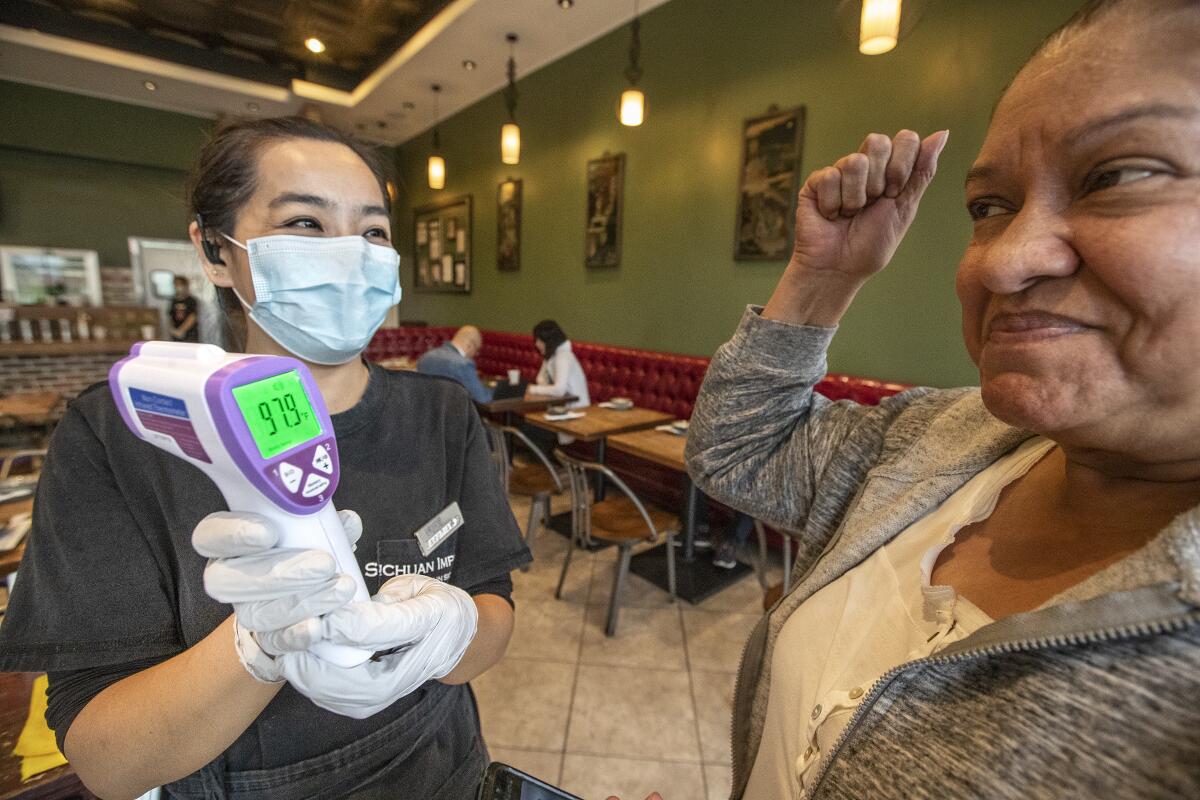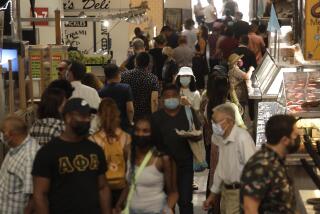Can Tom Hanks and the NBA stop coronavirus skepticism in boomers and others?

- Share via
Retired businessman Gary Martin Zelman was looking forward to his center court seat at Thursday’s Lakers game. Up until Wednesday night, he had planned to be there, rooting for his hometown NBA team, regardless of warnings that baby boomers should distance themselves from public places to help stem the rapid spread of the novel coronavirus.
Hours later, the NBA suspended its season and President Trump, who has downplayed the risk of the virus, imposed sweeping travel restrictions on visitors from Europe. An NBA player tested positive and actor Tom Hanks and wife Rita Wilson announced they are infected. In a matter of hours, Zelman — who is 57 with health issues — went from describing COVID-19 as a politically motivated fuss to acknowledging it poses real risks.
At 1:04 p.m., Zelman was saying: “We are adults and we should know how to take care of ourselves by now. If I have somewhere to go, I’m going to go.”
By 7:46 p.m.: “This changes the narrative. It’s time to take precautions.”
Zelman’s transition is one that public health experts say must happen on a vast scale among older Americans and those with chronic illnesses. It is this demographic that is at the greatest risk for severe and even deadly responses to COVID-19. But, health officials say, it’s been difficult to persuade older generations to comply as many of them resist such drastic measures.
Thomas Frieden, head of the Centers for Disease Control and Prevention during the Obama administration, said even his own mother was skeptical about the advice to isolate herself. Though she is 90 and lives in an area with an outbreak, she is active in three book clubs and two choirs, Frieden said. When he asked to talk to her about curtailing those activities, he said she agreed to listen but added, “I might not take your advice.”
The World Health Organization referred to the COVID-19 outbreak as a pandemic for the first time on Wednesday, adding some linguistic heft to the virus’ rapid spread across the globe. In California, four people have died of the novel coronavirus, each of them 60 or older. Several California counties have called for large gatherings to be canceled. Officials in Santa Clara County said all large events should be rescheduled, while recommending that church services be livestreamed.
But up until Wednesday night, at least, the new and expanding warnings did not seem to be reaching their target audience: baby boomers. Marc Lipsitch, a Harvard epidemiologist, blames mixed messaging: Trump, a baby boomer, has downplayed the virus’ potential impact by saying “it will go away ... be calm” and referring to heightened concern over COVID-19 as a hoax by Democrats. Public health officials say it is a threat so serious that it could cripple the American healthcare system.
On Wednesday, the president maintained that the risk to Americans remained low, but said that “we are at a critical time in the fight against the virus” before announcing the new travel restrictions.
Lipsitch said Trump’s vacillating messages have a trickle-down effect on state and local efforts to change behavior.
“It’s very hard for states and counties and cities to act when the president of the United States is saying we have this under control and containment is possible,” Lipsitch said.
Lipsitch said Americans should understand the risk COVID-19 poses, particularly to a healthcare system that can become quickly overwhelmed by an influx of patients and an exodus of sick medical workers.
“If you let the epidemic continue to spread and don’t do intensive social distancing, then you get more people needing intensive care than [available] ICU beds,” he said.
Health officials say there is a reason they urge older Californians to stay home, although the age that prompts such warnings differs depending on the agency. Officials across the country have alternately said the greatest risk is for people over 50, 60, 65 and 70.
Indeed, the risk of dying from COVID-19 increases with every decade, with those 60 and older accounting for more than 80% of the deaths in China, according to a major study in the Journal of the American Medical Assn. Chronic conditions such as heart disease, lung disease and diabetes made people more vulnerable.
“Based on the epidemiology of the disease so far, the greatest risk are in the elderly and those with chronic conditions,” said Dr. Jeffrey Klausner, an infectious disease expert at UCLA’s Fielding School of Public Health.

Unlike the flu, this virus does not seem to cause serious infection in children. There have been no deaths reported in children under 10.
“We don’t know why that is,” said Dawn Nolt, a pediatric infectious disease physician at Oregon Health & Science University. “We think everyone has some level of symptoms, such as fever or cough, but as far as we can tell the kids are very mildly affected.”
With the U.S. outbreak in its early stages, there isn’t yet good data on the ages and other characteristics of infected patients here.
“This is the first pandemic caused by a coronavirus,” World Health Organization chief Tedros Adhanom Ghebreyesus said Wednesday. “We have rung the alarm bell loud and clear.”
But that alarm bell was not causing Grace Magallon, 63, of East Los Angeles to break her normal routine.
“I’m not really that concerned,” Magallon said. “I know you can never be too careful, but it seems a little overboard.”
Magallon, who works for the on-demand delivery company Postmates, said she’s constantly entering restaurants to pick up orders she delivers to customers. Recently, she was required to have her temperature taken in order to enter a restaurant in Alhambra. It was another reminder, Magallon said, to use caution — wash her hands and use hand sanitizer — but she won’t change anything else about her daily life.
“It doesn’t scare me,” Magallon said.
The warnings haven’t slowed Bill Johnson, 80, either.
“I haven’t lost any sleep yet,“ said Johnson in the busy parking lot of Walmart about a mile away from where an elderly woman died from the coronavirus Monday in Elk Grove.
Johnson said he did not see a reason yet to change his daily schedule.
“I’ve lived through a bunch of these things,“ he said. “I haven’t had a cold in 30 years.“
The CDC said that, while many Americans may eventually become exposed to the coronavirus, individuals over 80 face the highest risk of severe illness. People who help care for elderly family members should begin organizing backup plans in case they need to distance themselves for a time.
Dr. Nancy Messonnier, director of the National Center for Immunization and Respiratory Diseases at the CDC, said she made the same recommendations to her own parents.
“I’ve asked them to stick close to home so they can avoid the potential risk of congregate settings,” Messonnier said.
Michael Mina, another Harvard epidemiologist, said American attitudes about government control of daily life also present a challenge.
“The way we work as a society is not amenable to top-down approaches,” Mina said.
He said that for local health officials charged with making decisions that have significant social and economic impacts, deciding how far to go and when to do it is intensely difficult, involving far more than health considerations. Political and economic concerns have also floated into debates, forcing scientists and public health experts to deal with competing expectations — and often anger — along with their traditional concerns.
“I do not envy the people who have to make these extraordinary decisions that are not black and white,” Mina said.
More to Read
Sign up for Essential California
The most important California stories and recommendations in your inbox every morning.
You may occasionally receive promotional content from the Los Angeles Times.














